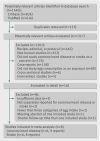Egg consumption and risk of coronary heart disease and stroke: dose-response meta-analysis of prospective cohort studies
- PMID: 23295181
- PMCID: PMC3538567
- DOI: 10.1136/bmj.e8539
Egg consumption and risk of coronary heart disease and stroke: dose-response meta-analysis of prospective cohort studies
Abstract
Objective: To investigate and quantify the potential dose-response association between egg consumption and risk of coronary heart disease and stroke.
Design: Dose-response meta-analysis of prospective cohort studies.
Data sources: PubMed and Embase prior to June 2012 and references of relevant original papers and review articles.
Eligibility criteria for selecting studies: Prospective cohort studies with relative risks and 95% confidence intervals of coronary heart disease or stroke for three or more categories of egg consumption.
Results: Eight articles with 17 reports (nine for coronary heart disease, eight for stroke) were eligible for inclusion in the meta-analysis (3,081,269 person years and 5847 incident cases for coronary heart disease, and 4,148,095 person years and 7579 incident cases for stroke). No evidence of a curve linear association was seen between egg consumption and risk of coronary heart disease or stroke (P=0.67 and P=0.27 for non-linearity, respectively). The summary relative risk of coronary heart disease for an increase of one egg consumed per day was 0.99 (95% confidence interval 0.85 to 1.15; P=0.88 for linear trend) without heterogeneity among studies (P=0.97, I(2)=0%). For stroke, the combined relative risk for an increase of one egg consumed per day was 0.91 (0.81 to 1.02; P=0.10 for linear trend) without heterogeneity among studies (P=0.46, I(2)=0%). In a subgroup analysis of diabetic populations, the relative risk of coronary heart disease comparing the highest with the lowest egg consumption was 1.54 (1.14 to 2.09; P=0.01). In addition, people with higher egg consumption had a 25% (0.57 to 0.99; P=0.04) lower risk of developing hemorrhagic stroke.
Conclusions: Higher consumption of eggs (up to one egg per day) is not associated with increased risk of coronary heart disease or stroke. The increased risk of coronary heart disease among diabetic patients and reduced risk of hemorrhagic stroke associated with higher egg consumption in subgroup analyses warrant further studies.
Conflict of interest statement
Competing interests: All authors have completed the ICMJE uniform disclosure form at
Figures





Similar articles
-
Meta-analysis of Egg Consumption and Risk of Coronary Heart Disease and Stroke.J Am Coll Nutr. 2016 Nov-Dec;35(8):704-716. doi: 10.1080/07315724.2016.1152928. Epub 2016 Oct 6. J Am Coll Nutr. 2016. PMID: 27710205 Review.
-
Egg consumption and cardiovascular risk: a dose-response meta-analysis of prospective cohort studies.Eur J Nutr. 2021 Jun;60(4):1833-1862. doi: 10.1007/s00394-020-02345-7. Epub 2020 Aug 31. Eur J Nutr. 2021. PMID: 32865658 Free PMC article.
-
A prospective study of egg consumption and risk of cardiovascular disease in men and women.JAMA. 1999 Apr 21;281(15):1387-94. doi: 10.1001/jama.281.15.1387. JAMA. 1999. PMID: 10217054
-
Egg consumption and risk of cardiovascular disease: three large prospective US cohort studies, systematic review, and updated meta-analysis.BMJ. 2020 Mar 4;368:m513. doi: 10.1136/bmj.m513. BMJ. 2020. PMID: 32132002 Free PMC article.
-
Food groups and risk of coronary heart disease, stroke and heart failure: A systematic review and dose-response meta-analysis of prospective studies.Crit Rev Food Sci Nutr. 2019;59(7):1071-1090. doi: 10.1080/10408398.2017.1392288. Epub 2017 Nov 7. Crit Rev Food Sci Nutr. 2019. PMID: 29039970
Cited by
-
Prognosis of pregnancy-associated breast cancer: a meta-analysis.BMC Cancer. 2020 Aug 10;20(1):746. doi: 10.1186/s12885-020-07248-8. BMC Cancer. 2020. PMID: 32778072 Free PMC article.
-
Effect of egg consumption on inflammatory markers: a systematic review and meta-analysis of randomized controlled clinical trials.J Sci Food Agric. 2019 Dec;99(15):6663-6670. doi: 10.1002/jsfa.9903. Epub 2019 Sep 30. J Sci Food Agric. 2019. PMID: 31259415 Free PMC article.
-
Nutrition and Cardiovascular Disease-an Update.Curr Atheroscler Rep. 2018 Jan 30;20(2):8. doi: 10.1007/s11883-018-0704-3. Curr Atheroscler Rep. 2018. PMID: 29383458 Review.
-
Mechanism and Potential of Egg Consumption and Egg Bioactive Components on Type-2 Diabetes.Nutrients. 2019 Feb 8;11(2):357. doi: 10.3390/nu11020357. Nutrients. 2019. PMID: 30744071 Free PMC article. Review.
-
Egg consumption and cardiovascular disease among diabetic individuals: a systematic review of the literature.Diabetes Metab Syndr Obes. 2014 Mar 24;7:121-37. doi: 10.2147/DMSO.S58668. eCollection 2014. Diabetes Metab Syndr Obes. 2014. PMID: 24711708 Free PMC article. Review.
References
-
- Ford ES, Capewell S. Coronary heart disease mortality among young adults in the U.S. from 1980 through 2002: concealed leveling of mortality rates. J Am Coll Cardiol 2007;50:2128-32. - PubMed
-
- Roger VL, Go AS, Lloyd-Jones DM, Benjamin EJ, Berry JD, Borden WB, et al. Executive summary: heart disease and stroke statistics—2012 update: a report from the American Heart Association. Circulation 2012;125:188-97. - PubMed
-
- Celermajer DS, Chow CK, Marijon E, Anstey NM, Woo KS. Cardiovascular disease in the developing world: prevalences, patterns, and the potential of early disease detection. J Am Coll Cardiol 2012;60:1207-16. - PubMed
-
- Ridker PM, Rifai N, Rose L, Buring JE, Cook NR. Comparison of C-reactive protein and low-density lipoprotein cholesterol levels in the prediction of first cardiovascular events. N Engl J Med 2002;347:1557-65. - PubMed
Publication types
MeSH terms
Substances
Grants and funding
LinkOut - more resources
Full Text Sources
Other Literature Sources
Medical
